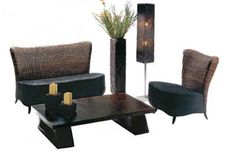A Cebu Furniture Exporter Equals Quality Products
Why Furniture From A Cebu Furniture Exporter Is The Best
Cebu has been dubbed the "Milan of Asia", and if you know your geography, you know what it implies.
Despite the lack of a major source of material and the difficulty in obtaining them, Cebuanos still come up with globally competitive products many the world over are in awe of. Why? What is the secret? In talks with many of those in the industry and with those outside of it, they all agree that the number one factor for the continuing stature that the products enjoy is the genius and creativity of the Cebuanos and of the Cebu furniture exporters and designers.

The lack of rattan, a major component, has challenged them to come up with other materials that may substitute for rattan or may be combined with it and thus lessen their need for it. With materials like stone, aluminum, wrought iron, wood, coconut, sea shells, bamboo, banana bark, abaca, steel, leather, tikog, sea grass, lampakanai and other indigenous materials, Cebuanos come up with the most innovative and exciting designs ever, yet still retain the beauty of form and function in the resulting products.
The second factor is the skill and artistry of the workers. Cebu has a history of its people’s ingenuity in making do with what they have, given the land that they cannot really depend on for food or livelihood. Cebuanos are used to making things work with whatever is on hand for them to work with. And because they are surrounded by beautiful, natural scenery, they can’t help but turn out things of beauty. They are naturally artistic. Capitalizing on masterful Filipino skills, the Philippine-made furniture today is a fusion of eastern craftsmanship, natural materials, age-old traditions, clever designs and modern technology.
Current TrendsEvery year, since 1988, Cebu International Furniture and Furnishings Exhibition or Cebu X, is held to showcase what a Cebu furniture exporter has to offer to the world. The exhibition is normally held every March at the Waterfront Cebu City Hotel and Casino, Cebu, Philippines. Organized by the Cebu Furniture Industries Foundation, Inc.(CFIF), FurnitureCebu.Com, it is now the “must-see” show among the many furniture design shows in Asia. The show has long been recognized as the preeminent exhibition of its kind in the Philippines, and through 17 years of design innovation and the occasional revolution, it is an influential barometer of the region’s design direction. Make your reservations now to attend the show at the CFIF website.

Based on the industry's latest offerings, and on talks with a Cebu furniture exporter/designer, Alan Murillo, we can surmise the following design trends in furniture:
• First, the trend to use mixed media as material for furniture. There are reasons for this, one of which is the scarcity of materials that have been used for furniture. Now, manufacturers and designers are using non-traditional materials and traditional craftsmanship mixed with modern technology. The materials may be ethnic but the sensibility is modern. Another reason for this mixing of materials is the new consciousness among the Cebu furniture export manufacturers not to waste nature’s bounty, but to enhance, protect and preserve it, as much as possible. Not only for this generation but for future generations as well.
• The use of material that makes the furniture light and airy. This is what the Europeans call the Asian lifestyle trend, or what some have dubbed as the tropical feel, or the urban ethnic. The material may be indigenous - coconut shell, sugarcane stalks, abaca, rope, sea grass, - but with the consummate Filipino craftsmanship and artistry married to state-of-the art machinery, the results are urbane designs, unmistakably contemporary, thoroughly modern.
• The result of all this is what Mr. Murillo calls a “responsible design.” The design with a social conscience. Materials such as coconut and bamboo, long used locally in relatively basic applications are now transformed into highly evolved finished pieces that comply with the strictest international standards on the use of non-toxic chemicals and the preservation of the environment. When designing furniture now, they see to it that no laws - social, environmental, or otherwise, are being violated.


